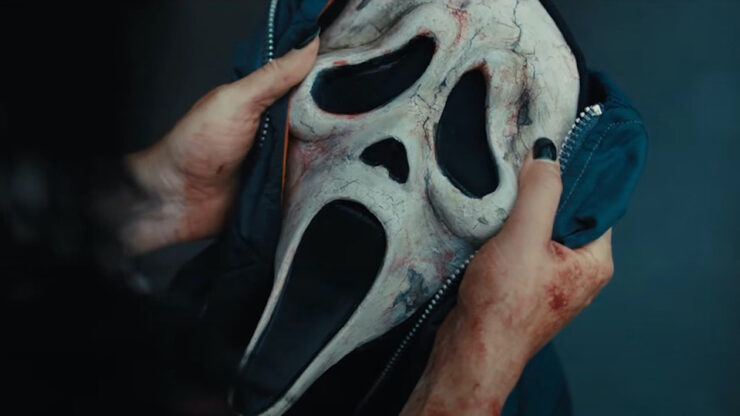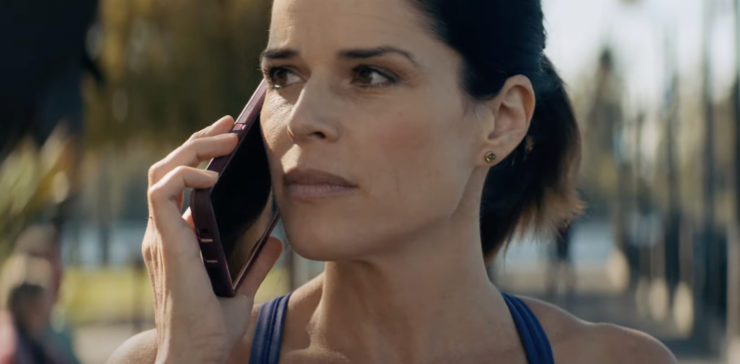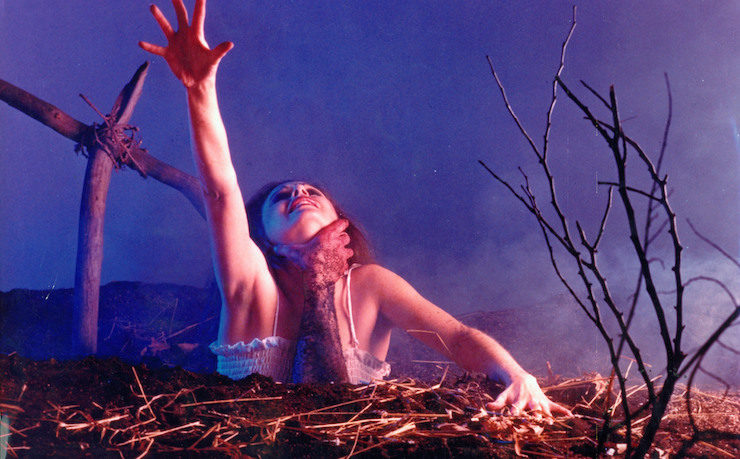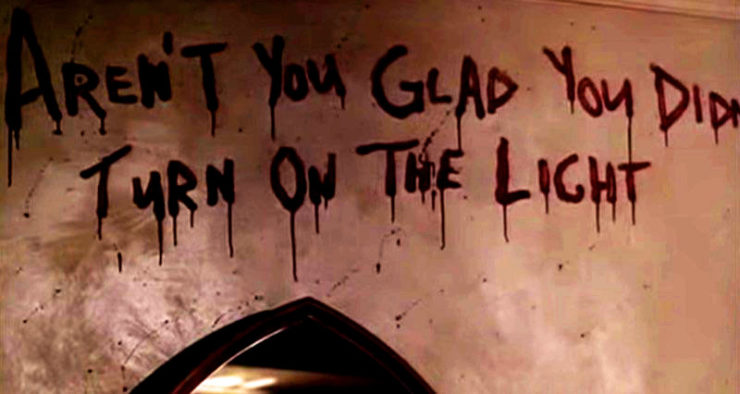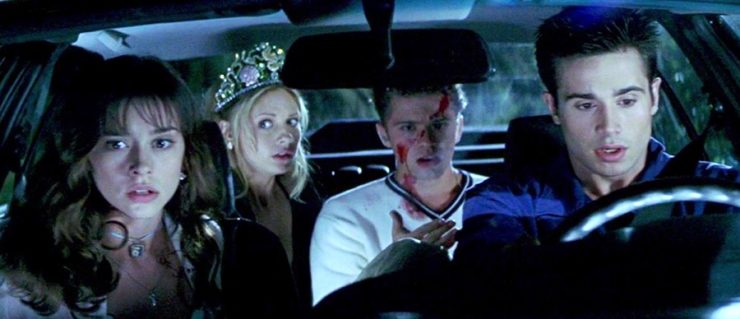“You either die a villain or live long enough to see yourself become the hero.” —Harvey Dent, if he were discussing slashers instead of superheroes
Scream VI is a movie that conjures up the image of the ancient ouroboros, the snake eating its own tail, which has long been a symbol of the cyclical nature of reality, from the turn of the seasons to death and rebirth. The specter of Ghostface has become ambivalent—they are both killer and hero in a franchise that isn’t bothered by the tension. It embraces the slasher’s strange afterlife.
Warning: Spoilers for the Scream franchise, including Scream VI, below.
Scream VI, set one year after the events of the previous installment, begins with a cold open featuring young professor Laura Crane (Samara Weaving) being murdered by a Ghostface. The scene imitates the original Scream‘s shocking dispatching of Drew Barrymore. Not so shocking this time. What is surprising is that, after Ghostface kills Laura, he removes his mask and we meet Jason Carvey (Tony Revolori), a former classmate of Richie Kirsch (Jack Quaid), one of the antagonists of the last film. We learn that Jason and his friend have planned to finish what Richie started (which, if you’ve lost track, is to get the Stab! movie franchise back on track). Is it possible that Scream is straying so far from its formula that it’s simply showing us, Columbo-style, who’s behind the mask in the cold open? Not to worry. The “real” Ghostface arrives to kill Jason and his roommate, berating them for tarnishing Richie’s legacy.
Here, Scream VI gives us a clue that’s only obvious in retrospect: this new installment is going to interrogate who Ghostface truly is, and who gets to wear the mantle.
How far we can deconstruct the slasher? Since Carol J. Clover’s landmark book Men, Women, and Chainsaws interrogated the trope of the “Final Girl” (coining that term in the process), slasher films have been reeling. Plenty of filmmakers have taken Clover’s insights to heart, from the recent Slumber Party Massacre remake to A Cabin in the Woods (2011) to The Final Girls (2015). But maybe no one has taken Clover’s insights as seriously as Wes Craven, who created the extremely-meta A New Nightmare just two years after Chainsaws bit into the genre of which he was the undisputed master. And of course, it was another two years after that, in 1996, that Craven teamed with Kevin Williamson to release Scream.
You know the beats by now—two killers share a single persona, Ghostface. Together, motivated by some personal connection on one hand and a quest for fame on the other, they wreak havoc on a friend group, at the center of which is our final girl. Along the way, a film nerd explains the rules of the film (which are increasingly a stretch, as the franchise continues). Teens are killed, the rule-breaking killers revealed, monologues monologued, and finally the killers are dispatched by the final girl.
As the rules of the cinematic game being played increasingly feel more generic and less pointed, the franchise has to work harder to say something interesting (and Jason’s pre-kill conversation with Laura lets us know the film very much wants to Say Something). Scream VI takes us to New York City—comparisons to the much (and deservedly) maligned Friday the 13th Part VIII: Jason Takes Manhattan are unavoidable, but work in Scream‘s favor. While Jason barely spent 30 minutes in Manhattan, Ghostface revels in the Big Apple as a broader canvas for their most brutal and bloody work yet. Big city staples like the corner bodega and the subway become settings for shocking set pieces. But the rules the movie is playing by (and with) feel increasingly arbitrary and sleight.
Mindy (Jasmine Savoy Brown), the new batch’s film nerd (and niece of original nerd Randy), declares that they’re now in “a franchise” and as such has new rules, such as “core characters aren’t safe” and “bigger budget and body count.” Scream made a splash by breaking the rules as a way to point to the killers. In the original film, Matthew Lillard’s Stu says, “I’ll be right back,” and doesn’t die. Roman (played by Scott Foley in Scream III) is a solo killer, breaking the fledgling franchise’s unwritten rule about having two killers.
None of the “Core Four” dies in Scream VI, nor does Courteney Cox’s Gale Weathers—a blatant violation of Mindy’s rule. This should tell us that one of those Four is the killer, but we know Ghostface in this installment is a trio (bigger and bloodier, remember?). Turns out Dermot Mulroney’s Detective Bailey and his two kids, Quinn and Ethan, are related to Richie, the aforementioned fan-boy Ghostface that was killed by new final girl Sam Carpenter (Melissa Barrera) at the end of the last movie.
Except Scream VI is all about the legacy of the franchise; the final set piece takes place in a literal museum to Ghostface in all their incarnations. Sam Carpenter is the daughter of original Ghostface Billy Loomis, and in this film, she wins by literally becoming Ghostface, donning her father’s Ghostface costume and taking up his knife. She thus becomes, in a very literal way, the Final Girl/Slasher fusion of Clover’s imagination. And of course she handily dispatches these would-be Ghostfaces. Because Sam is the true heir to the mantle. Ghostface is her destiny, and she can only save the day by becoming the one she fears.
Buy the Book
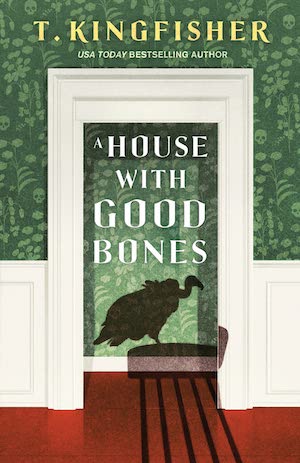

A House With Good Bones
The only way Scream VI could keep the Core Four (which is really five, counting Weathers) alive is by breaking the franchise rule. And they could only break the rule, according to Scream tradition, by making one of the Core Four the killer.
So Sam is the real Ghostface, but in yet another meta-twist, Ghostface is the real hero, here. This is not wholly new to the slasher genre—it doesn’t take too many installments before the slasher morphs into the hero of the franchise. Or, if not hero in the literal sense, at least the star. No one can name a victim from Friday the 13th Part VIII, but we all know it’s the one where Jason takes Manhattan. Whose nightmares does Freddy inhabit in The Final Nightmare? Who cares, as long as we get to see Freddy! And the recent Halloween trilogy went so far as to turn Michael Meyers into a Christ figure as part of its commentary on the enduring meaning of slashers.
So too, the Scream movies are as much about Ghostface as about who’s behind the mask (and with the biggest box office opening for any installment of the franchise yet, despite not having Neve Campbell’s Sydney Prescott, it seems to prove the theory that we don’t need a Final Girl). In this, Scream VI delivers in spades: The kills are the most brutal in the franchise yet. The film seems to know how silly the big reveal is, and doesn’t force us to wade through too much monologuing before getting back to the blood. “We know we’ll never top the original,” the film seems to be saying. “So excuse us while we up the body count.”
But what does it all mean for the future of not only the franchise, but the genre in general? How much more meta can slashers possibly get? And once you’ve turned your villain in to a hero, what’s left?
At this point, Scream has parodied slashers, sequels, trilogies, legacequels, and franchises. It might have finally run out of parodies, which means it’s reached truly scary territory: having to tell a new story.
JR Forasteros cut his teeth on Goosebumps books and Sword of Shannara. These days, he’s a pastor, author of Empathy for the Devil and scifi/fantasy junkie in Dallas, TX. Once he makes it through his to-read list, he plans to die historic on the Fury Road. Find him on Twitter or Instagram, or on the Fascinating Podcast where he is a co-host.










